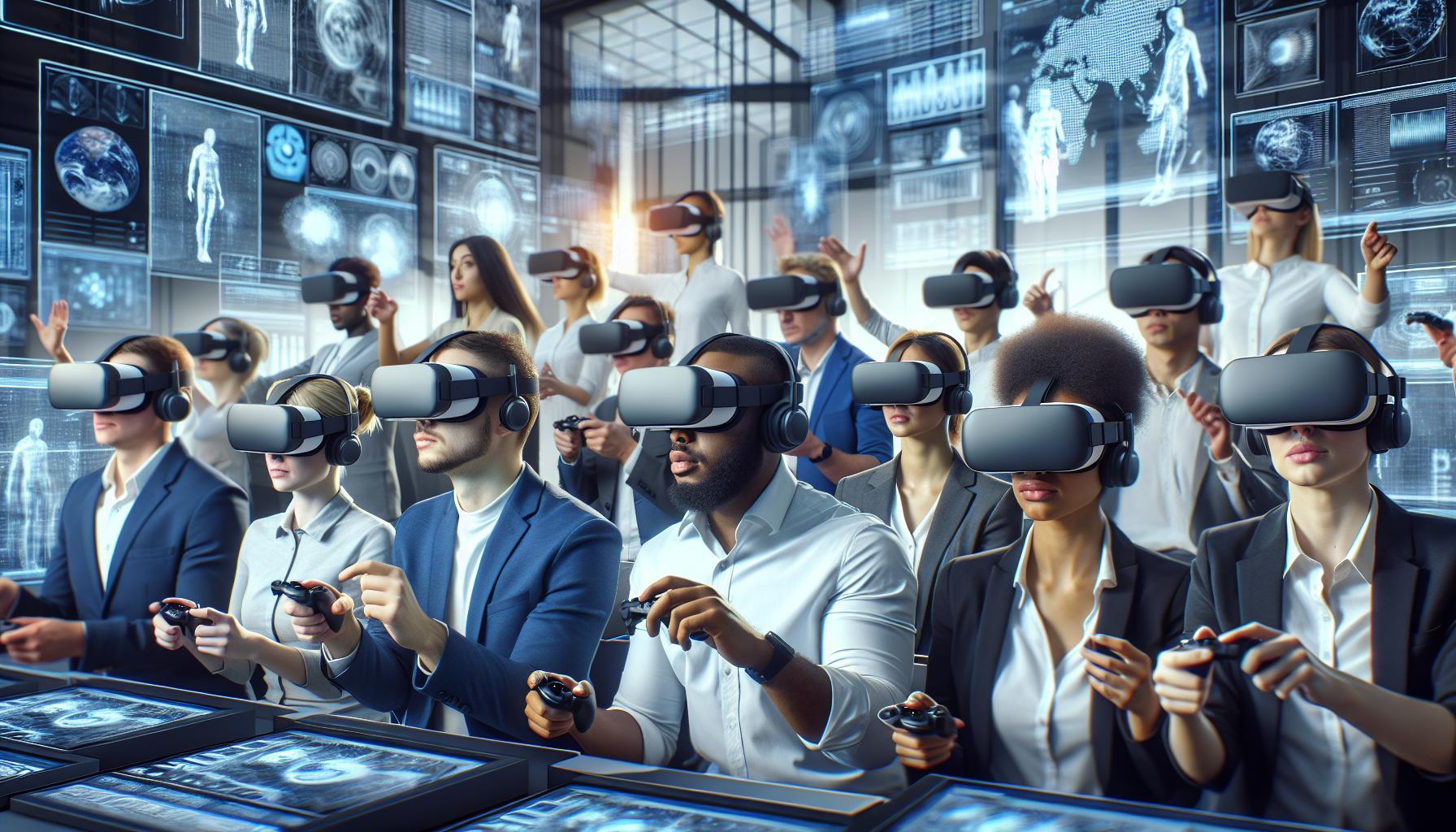Key Takeaways
- Immersive Learning Experience: Virtual reality training offers highly engaging, interactive environments that enhance skill development and mimic real-world scenarios without risks.
- Applications Across Industries: VR training is utilized in various sectors, notably healthcare and aviation, for realistic simulations that improve procedural knowledge and decision-making skills.
- Improved Knowledge Retention: The interactive nature of VR aids in better retention and recall of information, leading to enhanced performance metrics and skill application in the workplace.
- Cost-Effective Solution: By reducing the need for physical resources and travel, virtual reality training can lower overall training expenses while providing robust educational experiences.
- Future Innovations: Trends such as AI integration, cloud-based solutions, and mobile VR platforms are expected to enhance the accessibility and effectiveness of VR training programs.
- Collaboration and Gamification: Social VR avenues and gamification elements increase engagement and teamwork during training, making the learning process enjoyable and memorable.
Virtual reality training is revolutionizing how individuals and organizations approach skill development. By immersing users in lifelike environments, it offers a unique way to practice and refine skills without the risks associated with real-world scenarios. This innovative technology has found applications across various fields, from healthcare to aviation, providing a safe and controlled setting for learners.
As industries increasingly recognize the benefits of virtual reality, the demand for effective training solutions continues to grow. With its ability to enhance engagement and retention, VR training not only boosts performance but also reduces costs associated with traditional training methods. Exploring the potential of virtual reality in training can open doors to new possibilities, making it a game-changer in professional development.
Virtual Reality Training
Virtual reality training utilizes immersive simulations to create realistic environments for skill development. Users engage with virtual scenarios that mimic real-world situations, allowing them to practice skills without real-life risks. This technology enhances learning by providing interactive experiences that traditional methods cannot achieve.
Various sectors adopt VR training for its effectiveness. In healthcare, medical professionals utilize VR for surgical simulations, allowing them to refine techniques safely. Aviation training employs VR to simulate flight scenarios, enabling pilots to practice emergency procedures in a controlled setting.
Engagement levels rise with VR training. Users display improved knowledge retention due to the interactive nature of the training. Performance metrics often show enhancements post-training, demonstrating VR’s impact on skill acquisition and application.
Cost reduction is another benefit of virtual reality training. It decreases the need for physical resources, travel expenses, and instructor-led sessions. Organizations experience savings while simultaneously providing robust training solutions.
The growing demand for innovative training methods solidifies VR’s role in professional development. Its application across various industries illustrates a shift toward more effective and efficient training strategies.
Benefits of Virtual Reality Training

Virtual reality training offers numerous advantages that enhance learning outcomes and professional development across various sectors.
Enhanced Learning Experience
Enhanced learning experiences occur through immersive environments that engage users actively. VR training allows individuals to participate in realistic scenarios, facilitating hands-on practice that traditional methods cannot replicate. Participants manipulate virtual objects and interact with dynamic situations, promoting engagement and adaptability. Industries, such as healthcare, use VR to simulate complex procedures, enabling learners to refine skills in a safe setting without real-world consequences.
Improved Retention and Recall
Improved retention and recall result from the interactive nature of VR training. Studies indicate that learners retain information better when engaging in experiential learning. VR stimulates multiple senses, creating memorable experiences that reinforce knowledge retention. As users navigate simulated challenges, they develop problem-solving skills that translate directly to real-world applications. Consequently, organizations benefit from enhanced performance metrics, as employees apply learned skills effectively in their roles.
Applications of Virtual Reality Training

Virtual reality training has distinct applications across various sectors, proving its versatility and effectiveness in skill development. Notable areas include healthcare and corporate environments.
Healthcare and Medical Training
In healthcare, virtual reality facilitates realistic surgical simulations and emergency response training. Medical professionals engage with virtual patients, allowing them to practice complex procedures without the risks associated with real-life scenarios. Studies show that VR training enhances procedural understanding, as trainees can explore anatomy and practice techniques repeatedly. Institutions like hospitals and medical schools increasingly utilize VR technology to prepare students for high-stakes situations, improving their confidence and competence before they encounter real patients.
Corporate Training and Development
Corporate training and development benefit significantly from virtual reality’s immersive capabilities. Companies implement VR scenarios to enhance team collaboration, customer service skills, and safety training. By simulating real-world business challenges, employees gain practical experience that translates to improved decision-making and communication skills. VR training also enables organizations to assess employee performance through interactive scenarios, tailoring feedback to specific needs. Businesses adopting VR for training report increased engagement and knowledge retention, leading to better job performance and overall organizational success.
Challenges in Implementing Virtual Reality Training

Implementing virtual reality (VR) training presents several challenges, including cost and accessibility issues, as well as technological limitations that can hinder effective training deployment.
Cost and Accessibility Issues
Investing in VR training systems requires substantial financial resources. Hardware costs, such as VR headsets and advanced computers, can exceed $1,000 per user, posing a barrier for many organizations, particularly small businesses. Additionally, content development often necessitates hiring specialized VR developers, further escalating expenses. Accessibility for all employees remains a concern. Training must accommodate various user needs, including those with disabilities who may experience difficulties with traditional VR setups. Organizations must invest in adaptive technologies to ensure inclusivity, increasing overall training costs.
Technological Limitations
Technical challenges also impact the effectiveness of VR training. Software bugs and system compatibility issues can disrupt training sessions, leading to frustrated users. Moreover, high-performance computers are essential for seamless VR experiences, which not all organizations possess. Limited battery life of VR headsets can restrict training durations, reducing session effectiveness. Finally, constant advancements in VR technology necessitate regular updates and upgrades, compelling organizations to allocate ongoing budgets for maintenance and enhancements.
Future of Virtual Reality Training
The future of virtual reality (VR) training shows great promise, driven by emerging trends and technological innovations that enhance its effectiveness and accessibility across various sectors.
- Artificial Intelligence Integration: AI enhances VR training by personalizing learning experiences based on user performance and adapting scenarios in real-time. AI-driven analytical tools also track progress and provide feedback, making the training experience more efficient.
- Extended Reality (XR) Technologies: XR encompasses VR, augmented reality (AR), and mixed reality (MR), offering diverse immersive experiences. Organizations can develop comprehensive training solutions that leverage these technologies, providing learners with customizable environments tailored to specific needs.
- Cloud-Based Solutions: Cloud technology facilitates easier access to VR training programs. It reduces the need for high-performance local hardware, allowing organizations to deploy training modules across multiple locations while making updates seamless and efficient.
- Mobile VR Platforms: Advancements in mobile VR technologies make training more accessible. Employees can engage in immersive training experiences using mobile devices, thereby increasing participation and flexibility in learning.
- Collaboration and Social VR: Social VR platforms enable team training in virtual environments, fostering collaboration among remote employees. Participants can interact, communicate, and work together in real time, which enhances teamwork skills essential for many industries.
- Gamification Elements: Incorporating game-like features into VR training increases engagement. Elements such as points, levels, and leaderboards motivate learners, making the training process enjoyable while improving retention and application of skills.
- Cross-Industry Applications: VR training expands its reach into various sectors, including retail and education. Industries adopt VR for customer interactions, employee onboarding, and skill enhancement, creating targeted training strategies applicable across diverse scenarios.
- Data-Driven Insights: Organizations increasingly use data analytics to assess the effectiveness of VR training programs. Collecting performance metrics enables continuous improvement, allowing for refined training methodologies that address specific learning gaps.
The convergence of these trends and innovations suggests that VR training will evolve, becoming more effective in skill acquisition and more accessible for organizations of all sizes as the technology develops.
Virtual Reality Training
Virtual reality training is reshaping how individuals and organizations approach skill development. By immersing users in realistic scenarios, it fosters a deeper understanding and retention of knowledge. As various sectors embrace this innovative approach, the benefits become increasingly clear.
Despite challenges like cost and accessibility, advancements in technology are paving the way for broader adoption. The integration of AI and mobile platforms is making VR training more personalized and accessible. As organizations continue to explore these opportunities, VR training stands to become an essential tool for effective learning and professional growth. The future looks bright for this transformative training method.